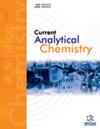利用超高效液相色谱-Q-轨道rap-MS/MS分析法同时定性和定量测定茜草叶中的33种化合物
IF 1.7
4区 化学
Q3 CHEMISTRY, ANALYTICAL
引用次数: 0
摘要
背景介绍鲁冰花(Rubus alceifolius Poir)叶片是一种广泛分布于东半球的药用植物材料。然而,迄今为止还没有关于其化学成分的报告。研究方法采用一套实验方案处理新鲜的茜草叶,制备冻干水提取物。随后,采用数据库亲和型超高效液相色谱-四极杆-Exactive-Orbitrap-串联质谱(UHPLC-Q-Exactive-Orbitrap-MS/MS)技术对提取物进行定性和定量分析。结果:根据 UHPLC-Q-Exactive-Orbitrap-MS/MS 仪器的质谱/质谱阐释以及与数据库的比较,定性鉴定出 33 种化合物。特别是严格区分了 12 种异构体,包括芹菜素与 2'-hydroxydaidzein 异构体、叶黄素 7-O- 葡萄糖醛酸与黄芩苷异构体、(+) 儿茶素与 (-) 表儿茶素异构体、3'-羟基芹菜素与 2'-hydroxydaidzein 异构体。(-)表儿茶素、3-O-咖啡酰奎宁酸与 4-O-咖啡酰奎宁酸与 5-咖啡酰奎宁酸、3,4-O-二咖啡酰奎宁酸与 3,5-O-二咖啡酰奎宁酸与 4,5-二咖啡酰奎宁酸。此外,在负离子或正离子模型下还发现了 21 种非同分异构化合物,如鞣花酸和没食子酸。定量分析结果表明,鞣花酸的含量最高(133.00 ± 3.50 μg/g),而(+)-4-胆甾烯-3-酮的含量最低(0.035 ± 0.0050 μg/g)。结论这些发现将有助于了解白头翁叶传统药用功能的物质基础,并找到其合适的质量标记。本文章由计算机程序翻译,如有差异,请以英文原文为准。
Simultaneous Qualitative and Quantitative Determination of 33 Compounds from Rubus Alceifolius Poir Leaves Using UHPLC-Q-Orbitrap-MS/MS Analysis
Background: Rubus alceifolius Poir leaves are a widely distributed medicinal plant material in the Eastern Hemisphere. However, there has been no report regarding their chemistry until now. Methods: Fresh R. alceifolius leaves were treated using a set of experimental protocols to prepare a lyophilized aqueous extract. Subsequently, the extract was qualitative and quantitatively analyzed using the database-affinity ultra-high-performance liquid chromatography-quadrupole-Exactive- Orbitrap-tandem mass spectrometry (UHPLC-Q-Exactive-Orbitrap-MS/MS) technology. Results: Based on MS/MS elucidation and comparison with the database in UHPLC-Q-Exactive- Orbitrap-MS/MS apparatus, 33 compounds were qualitatively identified. Especially, 12 isomers were strictly distinguished, including apigenin vs. 2'-hydroxydaidzein, luteolin 7-O-glucuronide vs. scutellarin, (+) catechin vs. (-) epicatechin, 3-O-caffeoylquinic acid vs. 4-O-caffeoylquinic acid vs. 5-Ocaffeoylquinic acid, and 3,4-O-dicaffeoylquinic acid vs 3,5-O-dicaffeoylquinic acid vs 4,5-Odicaffeoylquinic acid. In addition, 21 non-isomeric compounds, such as ellagic acid and gallic acid, were also found under negative or positive ion models. The quantitative analysis suggested that ellagic acid was found to be of the highest level (133.00 ± 3.50 μg/g), while (+)-4-cholesten-3-one was calculated to be of the lowest level (0.035 ± 0.0050 μg/g). Conclusion: These findings will help to understand the substance basis of the traditional medicinal functions of R. alceifolius leaves and to find their suitable quality markers.
求助全文
通过发布文献求助,成功后即可免费获取论文全文。
去求助
来源期刊

Current Analytical Chemistry
化学-分析化学
CiteScore
4.10
自引率
0.00%
发文量
90
审稿时长
9 months
期刊介绍:
Current Analytical Chemistry publishes full-length/mini reviews and original research articles on the most recent advances in analytical chemistry. All aspects of the field are represented, including analytical methodology, techniques, and instrumentation in both fundamental and applied research topics of interest to the broad readership of the journal. Current Analytical Chemistry strives to serve as an authoritative source of information in analytical chemistry and in related applications such as biochemical analysis, pharmaceutical research, quantitative biological imaging, novel sensors, and nanotechnology.
 求助内容:
求助内容: 应助结果提醒方式:
应助结果提醒方式:


